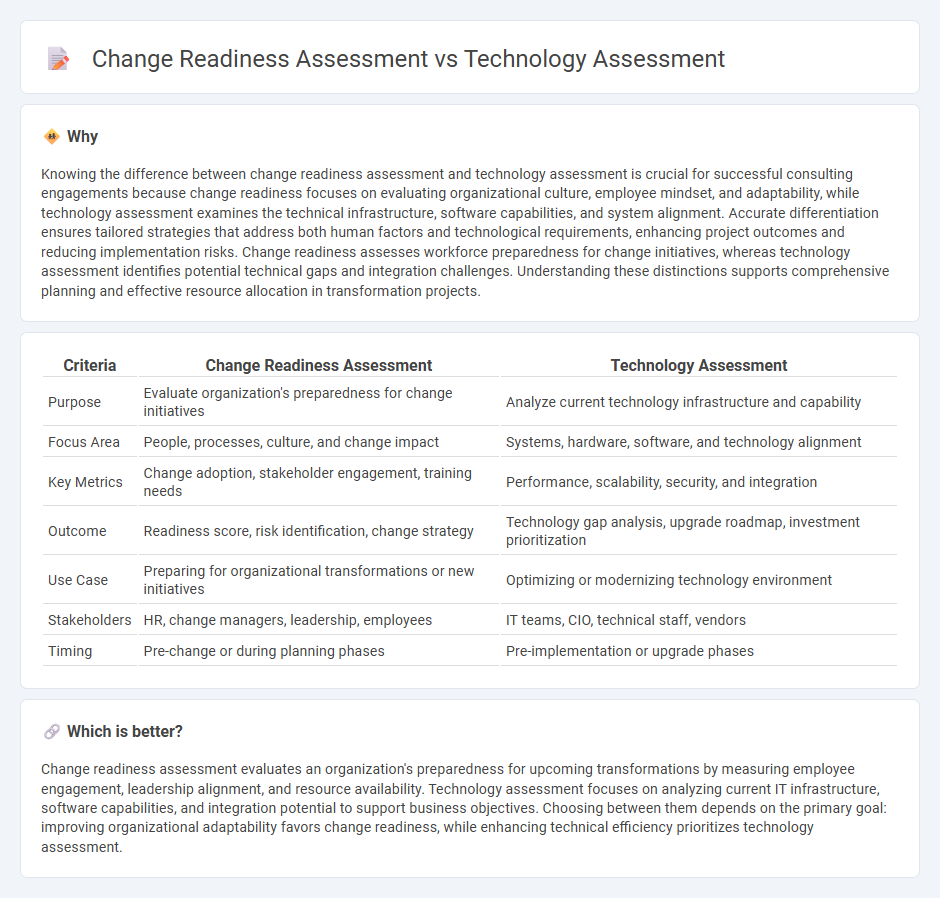
Change readiness assessment evaluates organizational capacity, employee adaptability, and leadership alignment to ensure successful transformation initiatives. Technology assessment focuses on the evaluation of current IT infrastructure, software capabilities, and technological gaps impacting business performance. Explore our detailed insights to understand how these assessments drive strategic consulting outcomes.
Why it is important
Knowing the difference between change readiness assessment and technology assessment is crucial for successful consulting engagements because change readiness focuses on evaluating organizational culture, employee mindset, and adaptability, while technology assessment examines the technical infrastructure, software capabilities, and system alignment. Accurate differentiation ensures tailored strategies that address both human factors and technological requirements, enhancing project outcomes and reducing implementation risks. Change readiness assesses workforce preparedness for change initiatives, whereas technology assessment identifies potential technical gaps and integration challenges. Understanding these distinctions supports comprehensive planning and effective resource allocation in transformation projects.
Comparison Table
| Criteria | Change Readiness Assessment | Technology Assessment |
|---|---|---|
| Purpose | Evaluate organization's preparedness for change initiatives | Analyze current technology infrastructure and capability |
| Focus Area | People, processes, culture, and change impact | Systems, hardware, software, and technology alignment |
| Key Metrics | Change adoption, stakeholder engagement, training needs | Performance, scalability, security, and integration |
| Outcome | Readiness score, risk identification, change strategy | Technology gap analysis, upgrade roadmap, investment prioritization |
| Use Case | Preparing for organizational transformations or new initiatives | Optimizing or modernizing technology environment |
| Stakeholders | HR, change managers, leadership, employees | IT teams, CIO, technical staff, vendors |
| Timing | Pre-change or during planning phases | Pre-implementation or upgrade phases |
Which is better?
Change readiness assessment evaluates an organization's preparedness for upcoming transformations by measuring employee engagement, leadership alignment, and resource availability. Technology assessment focuses on analyzing current IT infrastructure, software capabilities, and integration potential to support business objectives. Choosing between them depends on the primary goal: improving organizational adaptability favors change readiness, while enhancing technical efficiency prioritizes technology assessment.
Connection
Change readiness assessment evaluates an organization's capacity to adopt new initiatives, while technology assessment analyzes the suitability and impact of proposed digital tools. Integrating both assessments enables consultants to identify gaps in skills, infrastructure, and cultural alignment that could hinder successful technology implementation. This connection ensures that technology solutions are aligned with organizational readiness, enhancing the likelihood of seamless adoption and sustained transformation.
Key Terms
Digital Maturity (Technology Assessment)
Technology assessment evaluates an organization's digital maturity by analyzing the current infrastructure, software capabilities, and integration levels with emerging technologies to identify gaps and opportunities for innovation. Change readiness assessment measures the workforce's preparedness, cultural adaptability, and leadership commitment to effectively implement technological transformations. Explore more to understand how these assessments drive successful digital evolution.
Stakeholder Buy-in (Change Readiness Assessment)
Stakeholder buy-in in change readiness assessments evaluates the willingness and support of individuals affected by the change, ensuring smoother adoption and minimizing resistance. Technology assessment primarily focuses on the technical capabilities and suitability of new tools rather than stakeholder attitudes. Explore detailed strategies to enhance stakeholder engagement and improve change outcomes.
Risk Mitigation (both)
Technology assessment evaluates the potential risks associated with new systems, ensuring functionality, security, and compliance before implementation. Change readiness assessment identifies organizational vulnerabilities and resistance to change, facilitating strategies to minimize disruption and ensure smooth adoption. Explore how integrating both assessments enhances comprehensive risk mitigation strategies within your enterprise.
Source and External Links
Technology assessment - Wikipedia - Technology assessment (TA) is a practical process of evaluating new or emerging technologies' value and forecasting their societal impacts, ethical implications, and consequences to support informed decision-making and strategic planning across various fields including artificial intelligence, gene technology, and nanotechnology.
Technology Assessment: Evaluating Your Organization's Tools - Conducting a technology assessment involves identifying goals, budgeting, partnering with technical consultants, and aligning staff with new systems to evaluate and optimize an organization's current technology tools and procedures for improved performance and strategic alignment.
Technology assessment for emerging technology - OECD - Technology assessment provides policymakers with strategic intelligence on emerging technologies by analyzing their societal, economic, and environmental impacts to guide research, innovation policy, and public opinion in environments of high uncertainty and rapid change.
 dowidth.com
dowidth.com